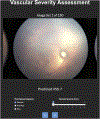Use of an Artificial Intelligence-Generated Vascular Severity Score Improved Plus Disease Diagnosis in Retinopathy of Prematurity
- PMID: 38866367
- PMCID: PMC11499038
- DOI: 10.1016/j.ophtha.2024.06.006
Use of an Artificial Intelligence-Generated Vascular Severity Score Improved Plus Disease Diagnosis in Retinopathy of Prematurity
Abstract
Purpose: To evaluate whether providing clinicians with an artificial intelligence (AI)-based vascular severity score (VSS) improves consistency in the diagnosis of plus disease in retinopathy of prematurity (ROP).
Design: Multireader diagnostic accuracy imaging study.
Participants: Eleven ROP experts, 9 of whom had been in practice for 10 years or more.
Methods: RetCam (Natus Medical Incorporated) fundus images were obtained from premature infants during routine ROP screening as part of the Imaging and Informatics in ROP study between January 2012 and July 2020. From all available examinations, a subset of 150 eye examinations from 110 infants were selected for grading. An AI-based VSS was assigned to each set of images using the i-ROP DL system (Siloam Vision). The clinicians were asked to diagnose plus disease for each examination and to assign an estimated VSS (range, 1-9) at baseline, and then again 1 month later with AI-based VSS assistance. A reference standard diagnosis (RSD) was assigned to each eye examination from the Imaging and Informatics in ROP study based on 3 masked expert labels and the ophthalmoscopic diagnosis.
Main outcome measures: Mean linearly weighted κ value for plus disease diagnosis compared with RSD. Area under the receiver operating characteristic curve (AUC) and area under the precision-recall curve (AUPR) for labels 1 through 9 compared with RSD for plus disease.
Results: Expert agreement improved significantly, from substantial (κ value, 0.69 [0.59, 0.75]) to near perfect (κ value, 0.81 [0.71, 0.86]), when AI-based VSS was integrated. Additionally, a significant improvement in plus disease discrimination was achieved as measured by mean AUC (from 0.94 [95% confidence interval (CI), 0.92-0.96] to 0.98 [95% CI, 0.96-0.99]; difference, 0.04 [95% CI, 0.01-0.06]) and AUPR (from 0.86 [95% CI, 0.81-0.90] to 0.95 [95% CI, 0.91-0.97]; difference, 0.09 [95% CI, 0.03-0.14]).
Conclusions: Providing ROP clinicians with an AI-based measurement of vascular severity in ROP was associated with both improved plus disease diagnosis and improved continuous severity labeling as compared with an RSD for plus disease. If implemented in practice, AI-based VSS could reduce interobserver variability and could standardize treatment for infants with ROP.
Financial disclosure(s): Proprietary or commercial disclosure may be found in the Footnotes and Disclosures at the end of this article.
Keywords: Artificial intelligence; Assistive diagnosis; Retinopathy of prematurity.
Copyright © 2024 American Academy of Ophthalmology. All rights reserved.
Conflict of interest statement
Drs. Campbell and Kalpathy-Cramer received research support from Genentech (San Francisco, CA). The i-ROP DL system has been licensed to Siloam Vision (Wellesley, MA) by Oregon Health & Science University and Massachusetts General Hospital, which may result in royalties to Drs. Chan, Campbell, Coyner, and Kalpathy-Cramer in the future. Dr. Chan is a consultant for Alcon (Ft Worth, TX). Dr. Chiang was previously a consultant for Novartis (Basel, Switzerland), and was previously an equity owner of InTeleretina, LLC (Honolulu, HI). Drs. Campbell, Chan, and Kalpathy-Cramer are equity owners of Siloam Vision. Dr. Coyner is a consultant for Siloam Vision. Dr. Kalpthy-Cramer was previously funded by grants from GE (to the institution).
Figures



References
MeSH terms
Grants and funding
LinkOut - more resources
Full Text Sources

